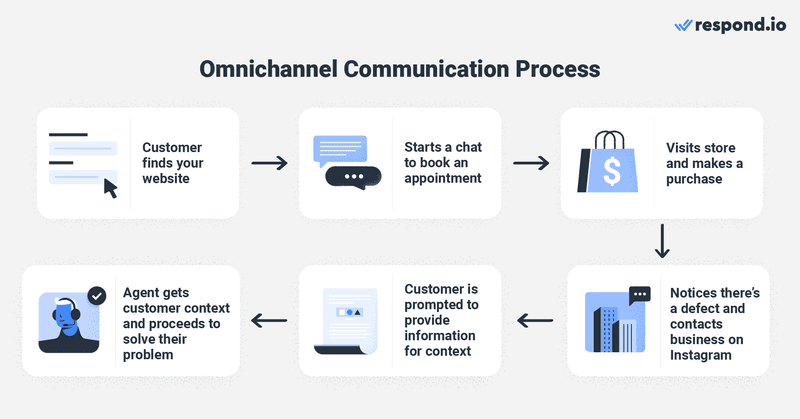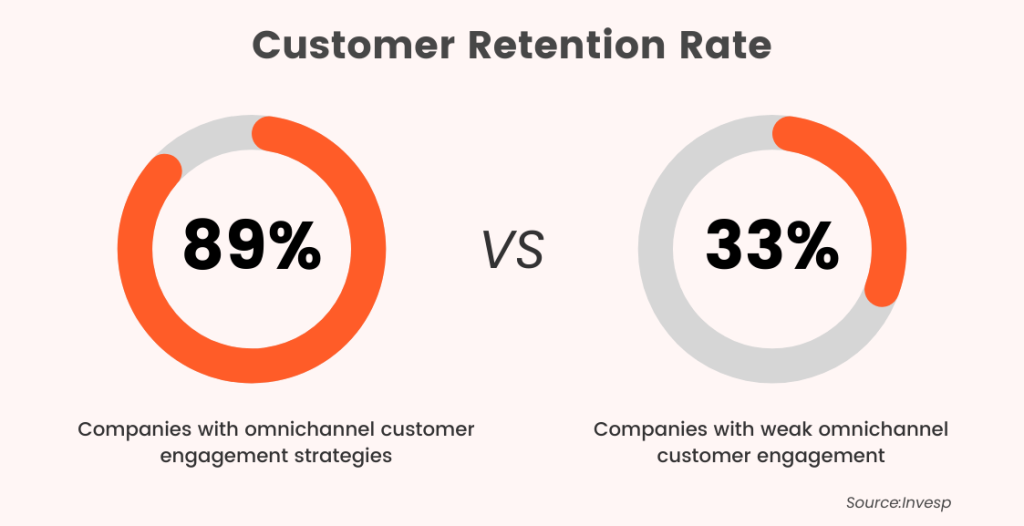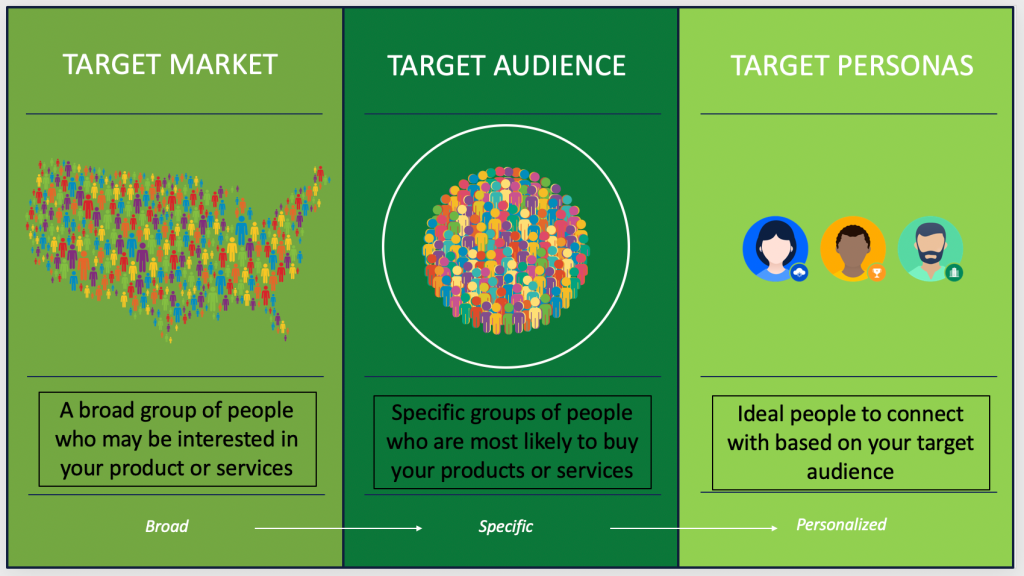Many companies are now taking the initiative to implement marketing and communication strategies that allow them to serve their customers at every touch point of their purchase journey, a.k.a omnichannel communication.
So, in this article, we explore what it actually is, its benefits for your business, and key steps to actually setting up an omnichannel communication channel.
Understanding Omnichannel Communication
What Is Omnichannel Communication?
Omnichannel communications is a customer service and marketing approach to provide a seamless and integrated experience across multiple communication channels.
It emphasizes the idea of being present across all relevant channels, enabling customers to interact and engage with your business using their preferred communication method.

[Source]
And as part of the omnichannel strategy, you can incorporate Voice over Internet Protocol (VoIP) technology to enable voice calls into the mix of communication channels. It allows voice calls to be transmitted over the internet, enabling customers to call your customer support or sales team directly using internet-connected devices — like computers, smartphones, or tablets.
Benefits Of Implementing An Omnichannel Communication Channel
Consistency
When a customer interacts with your brand on different platforms, they should encounter a consistent tone of voice, design elements, and brand identity. This unified approach helps reinforce your brand image and injects trust and familiarity into customers.
It also extends to the handling of customer inquiries and issues, and regardless of the channel used, customers should receive the same level of service and support.
Personalization
By leveraging data gathered from various customer touchpoints, you can gain insights into:
- Customer interests
- Purchase history
- Browsing behavior
- Demographic information
With this data, you can create targeted and relevant content, offers, and recommendations for each customer segment.

[Source]
Accessibility
Omnichannel communication provides customers with the freedom to choose how and when they interact with your business.
Some customers might prefer self-service options, like browsing an FAQ section, while others may opt for direct communication through phone calls or live chat.
By offering multiple channels and touchpoints, you can accommodate varying customer preferences, making it easier for customers to reach out when and where it suits them best.
How To Set Up An Omnichannel Communication Channel For Your Business
Understand Your Audience And Objective
You can only serve your customers well when you precisely know what your customers want and how they want to receive it.
And this is how you get the knee-deep understanding of the needs and preferences of your target audience, and address them correctly:
Identify Your Target Audience
Identifying the target audience involves understanding the characteristics and preferences (like pain points and interests) of the customers your business aims to engage with.

[Source]
- Study your existing customer base to look for patterns in demographics, buying habits, and communication preferences.
- Develop detailed buyer personas including different target audience segments along with key information such as age, gender, location, interests, pain points, and preferred communication channels.
- Gather direct feedback from customers through surveys, feedback forms, or direct outreach from your business email. Ask questions about their preferred communication channels, their experiences with your brand, and their expectations.
Define Communication Objectives
Defining clear communication objectives provide you with a solid roadmap for the communication strategy and ensure that your efforts are aligned with the overall business goals.
Here are key communication objectives:
- Providing prompt and helpful responses, resolve issues efficiently, and offer proactive support through preferred channels.
- Raising awareness about your brand, its values, and offerings through consistent messaging across various channels to attract and retain customers.
- Promoting products or services with targeted marketing campaigns and personalized offers to encourage conversions through a seamless customer journey.
- Nurturing relationships with current customers by offering exclusive benefits and seeking feedback.
Analyze Customer Preferences and Behaviors
Understanding which channels your customers prefer and how they like to engage will inform the selection and prioritization of communication channels.
This could involve collecting data from:
- Website Analytics — Analyze user behavior on your website to optimize UX.
- Social Media Metrics — Use social media analytics to help with content planning, and understanding resonance and engagement.
- Email Campaign Results — Analyze email metrics, like bounce rate and CTR through email tracking tools, to identify effective content and optimize campaigns.
- Customer Feedback Surveys — Gather direct insights from customers to enhance communication and experience.
- Social Listening and Sentiment Analysis — Monitor brand mentions and sentiment for better engagement.
Choose The Right Communication Channel(s)
Select Communication Channels Based On Your Identified Target Audience
The goal is to ensure that your target audience can interact with your business through their preferred channels seamlessly.
- Website live chat provides real-time support and assistance to customers as they browse your website. It allows you to address inquiries instantly and guide potential buyers through the sales process.
- Social media offers a platform for engaging content, customer feedback, and personalized communication. Through social media, you can build a tight-knit community by responding to both positive and negative feedback publicly, demoing transparency.
- Email allows for personalized messages, targeted promotions, and the delivery of essential updates or newsletters. It’s also suitable for more in-depth conversations or transactions that might require written documentation.
- While many communication channels have shifted towards purely digital platforms, phone support remains the goto. Some customers prefer speaking directly to a rep for complex issues or to seek a more personal touch in their interactions.
- SMS is an effective channel for sending concise, time-sensitive messages, such as appointment reminders, order updates, or time-sensitive promotions. This channel is particularly useful for engaging with customers who may not have immediate access to the internet or prefer brief, direct communication.
- For businesses with physical locations, in-person interactions are key. Whether it’s a retail store, a restaurant, or a service-oriented business, face-to-face interactions can leave a lasting impact on your customers.
Integrate Communication Channels (online + offline)
By effectively integrating online and offline channels, you can gain a holistic view of your customers’ preferences, behaviors, and interactions.
This 360-degree perspective allows you to make data-driven decisions and tailor marketing strategies to target customers with utmost precision.
Plus, a well-integrated communication approach ensures that data and interactions across different channels are synchronized and readily accessible to all relevant teams — ranging from marketing and sales to customer support. This cross-functional alignment enhances collaboration and empowers teams to work together cohesively.
Here’s how to achieve this integration:
- Enable seamless communication between different channels to maintain context.
- Use QR codes in physical locations to bridge online and offline experiences. For example, you can place QR codes on product labels that direct customers to online product reviews and additional information.
- Connect online (e.g., live chat, email) and offline (e.g., phone support, in-person interactions) support to ensure smooth transitions for customer queries.
- Encourage in-person customers to engage with online channels for better connectivity.
- Offer incentives for customers to engage with multiple channels and boost engagement. For instance, provide exclusive discounts for customers who make purchases both online and in-store.
- Timeliness is critical. Use tools like Userpilot that can trigger the right message to your users in-app so that you can guide them to the right feature when they need it the most.
Implement Technology Solutions
You need the following tech components to put your omnichannel communication strategy into action:
- CRM Systems: Centralize customer data, like interactions, purchase history, and preferences, for personalized experiences with a CRM system.
- Marketing Automation Platforms: Automate targeted campaigns based on customer behavior.
- Customer Service Tools: Provide timely and consistent support across channels with customer support tools like helpdesk software and ticketing systems.
- AI and Chatbots: Chatbots can handle routine inquiries via live chat, provide instant responses, and direct customers to the appropriate resources. AI-powered tools can also analyze customer behavior to deliver personalized content and recommendations.
- Social Media Management Tools: Simplify content scheduling, engagement monitoring, and sentiment analysis. These tools help you maintain an active and consistent presence on social media, and respond to customer inquiries and feedback promptly.
Train And Empower Your Team
By training and empowering your team, you create a culture that prioritizes customer satisfaction and embraces the omnichannel approach. A well-trained and motivated team is more likely to provide consistent and exceptional customer experiences.
Here’s how to do it:
- Train on Omnichannel Approach: Educate your team on how to navigate different channels, maintain context, deliver personalized interactions, and utilize data insights.
- Empower Employees to Deliver a Cohesive Experience: Encourage ownership of the complete customer experience, and provide resources to access customer data and insights across channels.
- Promote Cross-Channel Collaboration: Share best practices among teams responsible for different channels.
- Monitor and Measure Performance: Implement metrics related to customer satisfaction, response times, issue resolution, and channel effectiveness, and regularly review them.
- Reward Customer-Centric Behavior: Recognize and reward employees who stick with a customer-centric approach in their interactions.
Wrapping Up
Treating communication as an isolated situation is no longer sufficient to meet the diverse needs of your customers.
Customers, especially in 2023, don’t like to chase companies either to buy or to get a resolution. Instead, they expect you to have systems in place that allow them to get in touch with you at any time and however.
By implementing an omnichannel strategy, you can create a seamless and integrated experience for your customers, allowing them to engage with your brand across various touchpoints, whether it be through social media, email, SMS, or in-person interactions.
